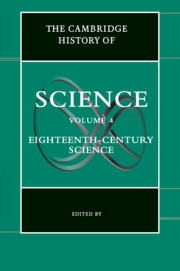Book contents
- Frontmatter
- 1 Introduction
- Part I Science and Society
- 2 The Legacy of the “Scientific Revolution”: Science and the Enlightenment
- 3 Science, the Universities, and other Public Spaces: Teaching Science in Europe and the Americas
- 4 Scientific Institutions and the Organization of Science
- 5 Science and Government
- 6 Exploring Natural Knowledge: Science and the Popular
- 7 The Image of the Man of Science
- 8 The Philosopher’s Beard: Women and Gender in Science
- 9 The Pursuit of the Prosopography of Science
- Part II Disciplines
- Part III Special Themes
- Part IV Non-Western Traditions
- Part V Ramifications and Impacts
- Index
- References
5 - Science and Government
from Part I - Science and Society
Published online by Cambridge University Press: 28 March 2008
- Frontmatter
- 1 Introduction
- Part I Science and Society
- 2 The Legacy of the “Scientific Revolution”: Science and the Enlightenment
- 3 Science, the Universities, and other Public Spaces: Teaching Science in Europe and the Americas
- 4 Scientific Institutions and the Organization of Science
- 5 Science and Government
- 6 Exploring Natural Knowledge: Science and the Popular
- 7 The Image of the Man of Science
- 8 The Philosopher’s Beard: Women and Gender in Science
- 9 The Pursuit of the Prosopography of Science
- Part II Disciplines
- Part III Special Themes
- Part IV Non-Western Traditions
- Part V Ramifications and Impacts
- Index
- References
Summary
The engagement of eighteenth-century governments and monarchs in the patronage of science had predominantly utilitarian motives. It was inspired, to very different degrees in different countries, both by a belief in the value of scientific knowledge for manufacturing, agriculture, medical improvement, public works, and warfare and by a perception of science as a form of culture whose promotion would lend luster to any regime seeking to parade its adjustment, however cautious, to the beneficent forces of enlightenment and modernity. Some of these motives had already borne scientific fruit in the seventeenth century, tentatively in England, where Charles II’s patronage of the Royal Society had been no more than nominal, and in a far more concrete fashion in France in the new and existing institutions that were supported under the influence of Louis XIV’s minister Colbert. From its foundation in 1666, the Académie Royale des Sciences was an instrument of the state: its members received material support, in the form of salaries and facilities, and in return the monarchy looked for a source of glory that would outshine the Royal Society in London and for services and expert advice of the kind it requested and received on the water supply to Versailles and on the inventions and machines that were routinely submitted to the Académie for judgment. It was with a similar aspiration to bind the interests of science to those of the state that Colbert commissioned Claude Perrault to design the Observatory of Paris in the late 1660s.
- Type
- Chapter
- Information
- The Cambridge History of Science , pp. 107 - 128Publisher: Cambridge University PressPrint publication year: 2003
References
- 2
- Cited by

